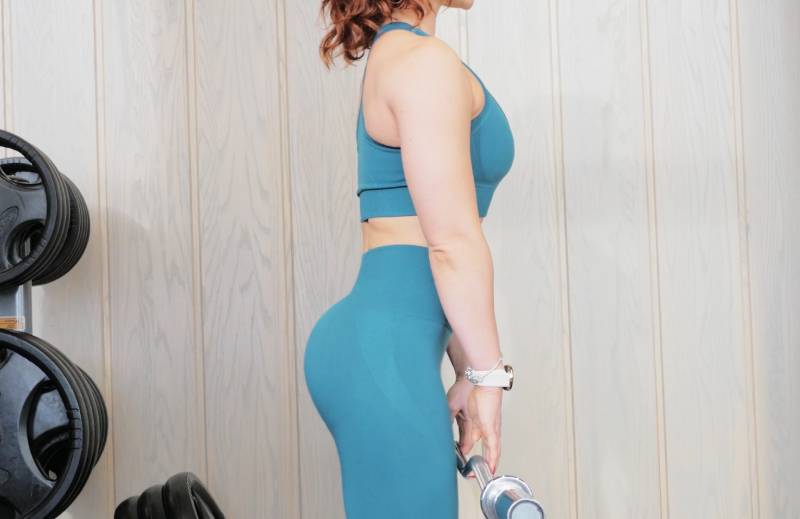Unleash the full potential of your workout routine with our comprehensive guide to mastering the Romanian deadlift. Whether you’re a beginner or seasoned gym enthusiast, perfecting your technique can elevate your training to new heights. Follow along as we break down each step, providing you with the expertise to maximize results and minimize the risk of injury. Elevate your strength and stability as we delve into the intricacies of this powerful exercise. From proper form to muscle engagement, we’ve got you covered. It’s time to sculpt and strengthen your posterior chain like never before. Let’s embark on this transformative journey together and unlock the full benefits of the Romanian deadlift. Get ready to conquer your fitness goals and experience the true potential of this dynamic exercise.
Understanding the Romanian Deadlift (RDL)
The Romanian deadlift (RDL) is a highly effective compound exercise that primarily targets the hamstrings, glutes, and lower back. Unlike the conventional deadlift, the RDL places greater emphasis on hip hinge movement, making it an essential addition to any strength and conditioning program. By mastering the RDL, individuals can improve their overall athletic performance, enhance functional strength, and reduce the risk of injury by reinforcing the posterior chain. Understanding the mechanics and benefits of the RDL is crucial for harnessing its full potential and achieving optimal results in your fitness journey.
When performed correctly, the RDL not only strengthens the targeted muscle groups but also enhances hip mobility and stability. Additionally, it contributes to improved posture and core strength, making it a valuable exercise for individuals seeking to address muscular imbalances and prevent lower back pain. As we delve deeper into the intricacies of the Romanian deadlift, you’ll gain valuable insights into its biomechanics, muscle activation, and the key components that contribute to its effectiveness. Mastering the RDL is not just about lifting weights; it’s about unlocking your body’s potential for optimal performance and injury prevention.
Benefits of incorporating RDL into your workout routine
Incorporating the Romanian deadlift into your workout routine offers a myriad of benefits that extend beyond the development of lower body strength. As a versatile exercise, the RDL promotes functional movement patterns, which are essential for activities of daily living and athletic performance. By engaging the posterior chain and reinforcing stability in the hips and lower back, individuals can enhance their overall athleticism and resilience against injuries. Furthermore, the RDL serves as an effective tool for improving hip mobility, which is often compromised in individuals with sedentary lifestyles or desk-bound jobs.
One of the primary advantages of the RDL is its ability to facilitate muscle hypertrophy in the hamstrings and glutes, leading to enhanced lower body aesthetics and strength. For athletes, this translates to improved performance in sprinting, jumping, and other explosive movements. Moreover, the RDL plays a pivotal role in enhancing hip extension, a fundamental movement pattern utilized in various sports and physical activities. By mastering the Romanian deadlift, individuals can unlock their potential for explosive power and agility, contributing to a well-rounded and functional physique.
Proper form and technique for the Romanian Deadlift
Achieving mastery in the Romanian deadlift begins with a solid foundation in proper form and technique. Without the correct execution, individuals may risk injury and compromise the effectiveness of the exercise. To perform the RDL correctly, start by standing with your feet hip-width apart and the barbell positioned in front of you. Engage your core, maintain a neutral spine, and initiate the movement by hinging at the hips while keeping a slight bend in the knees. As you lower the barbell towards the ground, focus on pushing your hips back while maintaining a straight back and keeping the barbell close to your body.
Throughout the movement, it’s crucial to maintain tension in the hamstrings and glutes, ensuring that the load is primarily borne by the posterior chain. Avoid rounding your back or allowing the barbell to drift away from your body, as this can place excessive stress on the lower back and lead to potential injuries. Once you reach the end of the range of motion, reverse the movement by driving your hips forward and returning to the standing position. Pay close attention to the tempo and control of the movement, emphasizing the eccentric phase to maximize muscle engagement and strength development. By mastering the proper form and technique of the Romanian deadlift, individuals can reap the full benefits of this transformative exercise while minimizing the risk of injury.
Muscles worked during the Romanian Deadlift
The Romanian deadlift is a compound exercise that targets multiple muscle groups, making it a highly efficient movement for developing strength and stability in the lower body and posterior chain. The primary muscles worked during the RDL include the hamstrings, glutes, and erector spinae, with secondary involvement of the quadriceps, lats, and core musculature. As individuals perform the hip hinge movement and lower the barbell, the hamstrings undergo significant eccentric contraction, leading to muscle fiber recruitment and subsequent hypertrophy.
Moreover, the glutes play a critical role in the RDL, acting as powerful hip extensors that propel the body back to the standing position. By engaging the gluteal muscles, individuals can enhance their hip strength and explosive power, contributing to improved athletic performance and functional movement patterns. Additionally, the erector spinae, which runs along the length of the spine, is actively engaged during the RDL to maintain spinal integrity and resist flexion, thereby promoting a strong and stable core. Understanding the intricate muscle activation patterns during the Romanian deadlift is essential for individuals seeking to optimize their training and maximize hypertrophy in the targeted muscle groups.
Common mistakes to avoid when performing the Romanian Deadlift
While the Romanian deadlift is a highly effective exercise for developing lower body strength and stability, several common mistakes can hinder its efficacy and lead to potential injury. One of the most prevalent errors is rounding the back during the descent phase, which places excessive strain on the lumbar spine and increases the risk of disc herniation or muscle strains. It’s essential to maintain a neutral spine throughout the movement, emphasizing proper hip hinge mechanics and engaging the core to support the lower back.
Another common mistake is extending the knees too early during the ascent, which shifts the emphasis away from the hamstrings and glutes, compromising the effectiveness of the exercise. To maximize muscle engagement and strength development, individuals should focus on driving the hips forward and fully extending the hips before straightening the knees. Additionally, using excessive weight beyond one’s capacity can lead to compensatory movements and poor form, diminishing the benefits of the RDL while heightening the risk of injury. By addressing these common mistakes and prioritizing proper form and technique, individuals can harness the full potential of the Romanian deadlift and minimize the likelihood of setbacks in their fitness journey.
Variations of the Romanian Deadlift for different fitness levels
As individuals progress in their fitness journey, incorporating variations of the Romanian deadlift can provide new challenges and stimulate further muscle growth and strength development. For beginners or individuals with limited mobility, the single-leg Romanian deadlift offers a scaled-down version of the exercise, focusing on unilateral stability and balance. By performing the single-leg variation, individuals can address muscular imbalances and enhance proprioception while reducing the load on the lower back.
For advanced lifters seeking to intensify their training, the deficit Romanian deadlift presents a formidable challenge by increasing the range of motion and placing greater emphasis on hip mobility and hamstring flexibility. Elevating the feet on a platform or step creates a deeper stretch in the hamstrings and demands a higher degree of strength and stability to execute the movement effectively. Furthermore, the kettlebell Romanian deadlift provides a unique stimulus by incorporating the use of kettlebells, promoting grip strength and enhancing the engagement of stabilizing muscles.
By integrating these variations into their training regimen, individuals can diversify their workout routine, target different aspects of strength and stability, and overcome plateaus in their progress. Whether you’re a novice or seasoned lifter, exploring the various adaptations of the Romanian deadlift can add depth and complexity to your training, leading to continuous improvements in strength, muscle development, and overall physical performance.
Incorporating the Romanian Deadlift into your workout program
Integrating the Romanian deadlift into your workout program can significantly enhance the overall effectiveness of your training regimen, whether your goal is to build strength, improve athletic performance, or enhance muscular development. When structuring your workout routine, consider incorporating the RDL as a foundational movement that targets the posterior chain and reinforces hip hinge mechanics. By placing the RDL early in your workout, you can capitalize on the body’s fresh energy and maximize muscle recruitment in the targeted areas.
Furthermore, pairing the Romanian deadlift with complementary exercises such as hip thrusts, glute bridges, and hamstring curls can create a synergistic effect, leading to comprehensive development of the lower body musculature. Additionally, individuals can experiment with different rep ranges and loading parameters to tailor the RDL to their specific fitness goals, whether it’s strength and power development or hypertrophy-focused training. By strategically integrating the Romanian deadlift into your workout program, you can optimize muscle activation, promote symmetrical development, and lay the groundwork for continuous progress in your fitness journey.
Tips for maximizing results with the Romanian Deadlift
To maximize results with the Romanian deadlift, it’s essential to prioritize consistency, progression, and attention to detail in your training approach. Start by mastering the fundamentals of the RDL, ensuring that your form and technique are impeccable before progressing to heavier loads or advanced variations. Focus on gradual progression in weight and volume, allowing your body to adapt and grow stronger over time while minimizing the risk of overtraining or injury.
Moreover, incorporating tempo and eccentric-focused RDL variations can elicit greater muscle damage and subsequent hypertrophy, leading to enhanced strength and muscular development. By controlling the descent phase of the RDL and emphasizing the stretch in the hamstrings, individuals can stimulate greater muscle fiber recruitment and promote structural adaptations in the targeted muscle groups. Additionally, implementing proper breathing techniques and bracing the core during the RDL can enhance intra-abdominal pressure, providing a stable platform for lifting heavier weights and minimizing the risk of spinal injury.
Finally, prioritizing recovery and adequate rest between RDL sessions is crucial for allowing the body to adapt and grow stronger. Incorporate mobility and stretching exercises to maintain optimal joint health and flexibility, ensuring that you’re primed for each RDL session. By implementing these tips and strategies, individuals can optimize their training approach, maximize results with the Romanian deadlift, and unlock their full potential for strength and muscular development.
Precautions and safety measures when performing the Romanian Deadlift
While the Romanian deadlift offers a plethora of benefits for strength and stability development, it’s essential to observe precautions and adhere to safety measures to minimize the risk of injury. Prior to performing the RDL, individuals should undergo a thorough warm-up routine that includes dynamic stretches, mobility exercises, and activation drills to prepare the body for the demands of the exercise. By priming the muscles and joints, individuals can reduce the likelihood of strains or soft tissue injuries during the RDL.
Furthermore, paying close attention to proper footwear and lifting environment is crucial for ensuring stability and traction during the RDL. Opt for flat-soled shoes or weightlifting-specific footwear to establish a solid base and avoid slipping or instability. Additionally, maintaining a controlled and deliberate tempo during the RDL can mitigate the risk of sudden jerky movements or loss of balance, promoting a smooth and safe execution of the exercise.
Individuals should also be mindful of their individual limitations and avoid ego-lifting or attempting weights beyond their capacity, as this can compromise form and lead to potential injury. By respecting your body’s capabilities and gradually progressing in your training, you can create a safe and sustainable approach to mastering the Romanian deadlift. Lastly, seeking guidance from a qualified fitness professional or coach can provide valuable insights and feedback on your RDL technique, ensuring that you’re on the right path to achieving optimal results while safeguarding your well-being.
Conclusion and the importance of including RDL in your fitness regimen
In conclusion, mastering the Romanian deadlift is a transformative journey that empowers individuals to unlock their full potential for strength, stability, and muscular development. By understanding the biomechanics, benefits, and proper execution of the RDL, individuals can harness its full potential and experience the profound impact it can have on their fitness journey. From targeting the posterior chain to enhancing athletic performance, the Romanian deadlift stands as a cornerstone exercise that yields multifaceted benefits for individuals of all fitness levels.
Incorporating the RDL into your workout program offers a gateway to comprehensive lower body development, functional movement patterns, and injury resilience. By adhering to proper form, avoiding common mistakes, and exploring variations tailored to your fitness level, individuals can maximize the effectiveness of the RDL and achieve continuous progress in their training. Furthermore, prioritizing safety measures, progression, and recovery strategies ensures that individuals can reap the benefits of the RDL while safeguarding their well-being.
As you embark on your journey to master the Romanian deadlift, remember that consistency, attention to detail, and a commitment to continuous improvement are the cornerstones of progress. By integrating the RDL into your fitness regimen with intention and purpose, you can elevate your training to new heights and experience the true potential of this dynamic exercise. Embrace the challenge, embrace the growth, and embrace the transformative power of the Romanian deadlift in sculpting a stronger, more resilient you.
So, gear up, step into the gym, and get ready to conquer your fitness goals with the Romanian deadlift as your steadfast companion. The journey awaits, and the rewards are within reach. It’s time to unleash your full potential and experience the transformative impact of mastering the Romanian deadlift. Let’s elevate your training, sculpt your physique, and embark on this empowering journey together. The Romanian deadlift awaits, ready to propel you towards your fitness aspirations. Are you ready to embrace its full potential?



